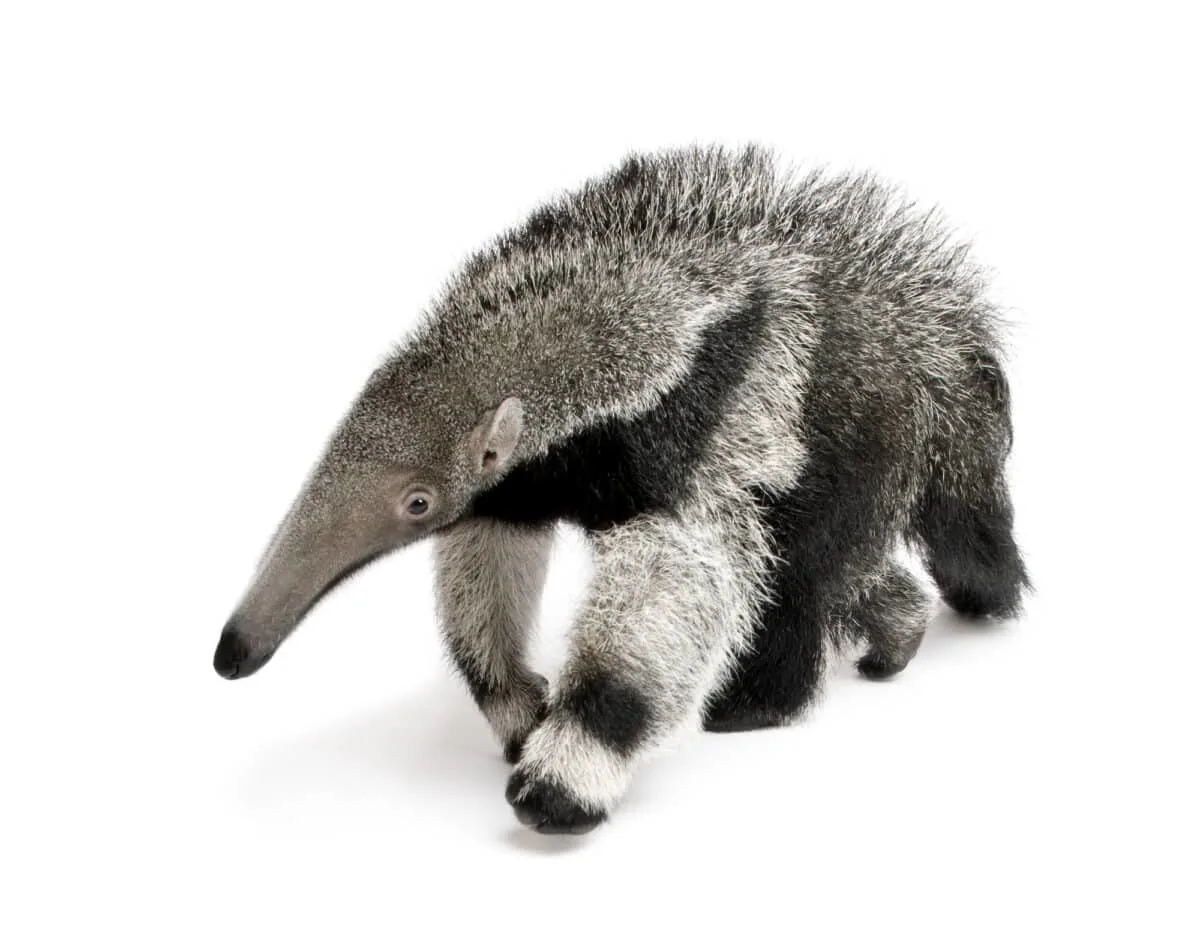Have you heard about the Giant Anteater? They’re a magnificent animal with very special behaviors. Let’s find out about this amazing animal!
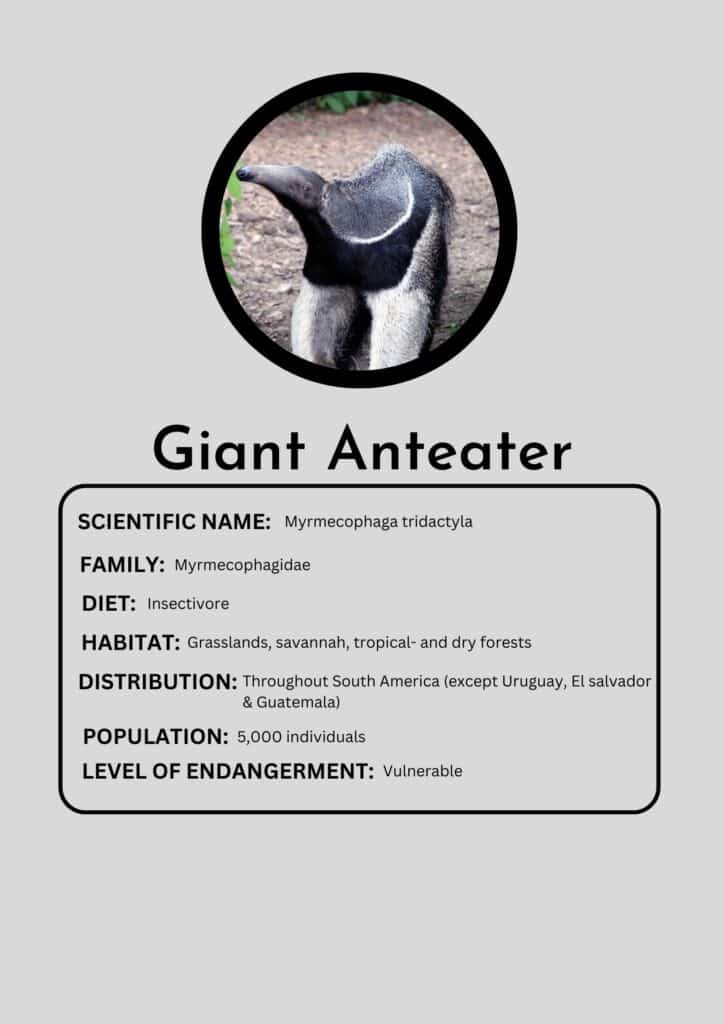
Appearance
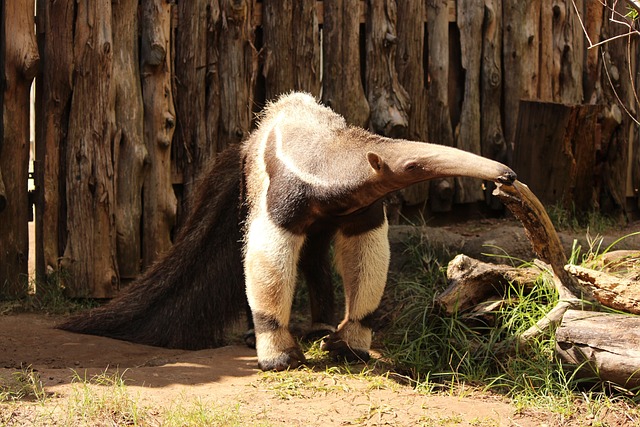
The Giant Anteater is one of four species that make up the family of Myrmecophagidae. As the name implies, the Giant Anteater is the largest species within this family. This family forms part of the Pilosa order – Pilosa meaning “hairy” in latin – which also includes sloths.
A total body length measuring 5 ft 11 in – 7 ft 2 in makes them well deserving of their name as “giant” anteaters. Males and females weigh on average between 73-110 lb and 60-104 lb respectively. Other than males being slightly heavier, there is no external way of differentiating between the sexes. They are easily identified by means of its long snout.
Their snout holds a 2 ft long tongue used for slurping their namesake; ants. This lengthy tongue is sufficient for them to consume food and they do not possess any teeth.
Its fur coat is uniformly gray-brownish, except for a black and white stripe on each shoulder and lighter front legs. Additionally, they have a mane of bristle-like hairs that runs the length of its spine, and which extends to a long and bushy tail. The tail acts both as a blanket or shade-provider depending on the weather. Moreover, they position their tails over them when they are sleeping to camouflage themselves from various dangers.
Their front feet are equipped with sharp claws, thereby forcing them to walk on their knuckles, much like chimpanzees and gorillas do. When Giant Anteaters feel threatened they will stand on their hindlegs and defend themselves with these sharp claws. Reportedly, they are even able to fend off pumas in this way.
The Giant Anteater’s tiny eyes are indicative of their poor eyesight. However, their incredible sense of smell makes up for this. Their sense of smell is 40 times more sensitive than a human’s.
Habitat and Distribution
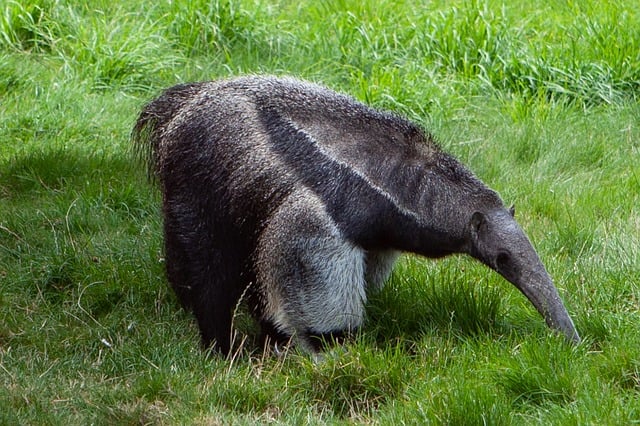
The Giant Anteater is a species native to South America and occurs throughout the continent with the exception of Uruguay, El Salvador and Guatemala, where they have gone extinct. They are also present in Central America, but in much smaller numbers. Overall the population of Giant Anteaters have significantly diminished in recent years and they are considered to be one of the most endangered mammals in South America.
Typically they reside in grasslands, savannahs, wetlands, tropical- and dry forests. They are fairly flexible with the type of landscape they inhabit, but the prevalence of their sole food source, ants, is a decisive factor. They do not make dens or nests that they live in permanently. Instead they curl up in any secluded spot available at a given time.
The Giant Anteater diverges from other anteaters, and their sloth-cousins, in that they are largely terrestrial creatures and spend most of their time on the ground. Other anteater species are typically arboreal, meaning that they live most of their lives above ground in treetops. Traditionally it is a diurnal animal, indicating that they are mostly active in the daytime. However, if they reside in an area with a high density of humans they tend to be more active after dark.
Diet
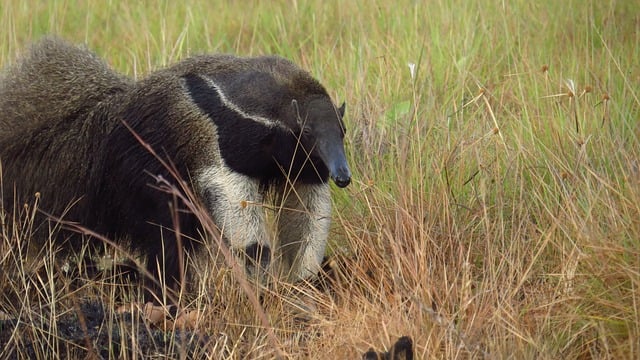
Giant Anteaters are insectivores and almost exclusively feed on ants and termites. On average they plunge into about 200 ant mounds per day in order to consume their required daily dosage of 30,000 ants. Their fantastic sense of smell allows them to locate the ant mounds, and according to research it is so refined it even enables them to distinguish between different ant species.
They use their sharp claws to create a hole in which they can stick their snout and long tongue into. By means of sticky saliva and flicking their tongue at a rate of 160 times/minute they retrieve large amounts of ants. Ants will fight back with bites and stings, and therefore they only spend a few minutes by each ant mound. Further, they avoid destroying the colony so that they can return for another meal at a later stage.
Mating and Life Cycle
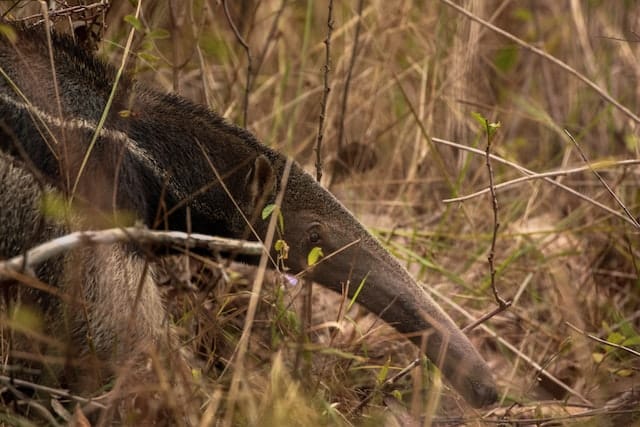
Mating is the only time during which the Giant Anteater engages with others of its kind. Sexual maturity occurs between the ages of 2,5 – 4 years. The gestation period lasts roughly 6 months, after which a mother will give birth to a single pup.
Pups will nurse off of the mother’s mammary glands for three months before gradually moving onto solid food. For as long as 9 months pups will piggyback their mothers, where they are well camouflaged due to having identical stripes. Moreover, this makes the mother appear much larger and thus deter predators. After 2 years the pup is fully independent and parts ways with its mother.
Sadly pups have a very high mortality rate due to being highly susceptible to various diseases, only 50% will survive more than 3 months. This slow reproductive rate adds further to their endangerment. In the wild a Giant Anteater will typically reach an age of 15 years, although the oldest age recorded in captivity is 26 years.
Cause of Endangerment

The Giant Anteater features on the IUCN Red List of Endangered Animals. Only 5,000 individuals currently remain in the wild, classifying them as a vulnerable species.
As with so many other endangered species, habitat loss is a primary threat facing the Giant Anteater. Other than human developments, their habitats are shrinking due to sugar cane farmers burning large areas of grasslands. Additionally, Giant Eaters are prone to getting caught in these fires as they can’t move at a rapid pace and have highly flammable fur.
Roads are also responsible for fragmentation of their habitat and they frequently become roadkill. They frequently fall prey to jaguars and pumas as well. Similarly, humans hunt them; either for food or due to them disrupting agricultural activities.
Bet you didn’t know about the giant anteater
Despite not being aggressive by nature, there is documentation of Giant Anteaters killing humans with their sharp claws – which reach 4 inches in length – when feeling cornered or threatened.
Giant Anteater’s are neither agile nor nimble, but if a situation calls for it they may reach speeds of 30 mph. Surprisingly, they are also talented swimmers and thoroughly enjoy a dip. Moreover, they have an extremely low body temperature for a mammal. Normally mammals have a body temperature of 97°F, whereas the Giant Anteater’s temperature measures 91°F.
During the colonization of the South Americas, the Spanish brought Giant Anteaters to Europe for display purposes. Initially, it was believed that the species only consisted of females which reproduced by means of their snouts.
If you like to read more about mammals have a look at our other articles. Thank you for reading giant anteater.
- Magpie Bird Is Reunited with Her Dog Best Friend - April 24, 2024
- Dog Saves Another Dog From Drowning in Fish Pond - April 23, 2024
- Man On Motorbike Rescues Cat From Highway - April 23, 2024

